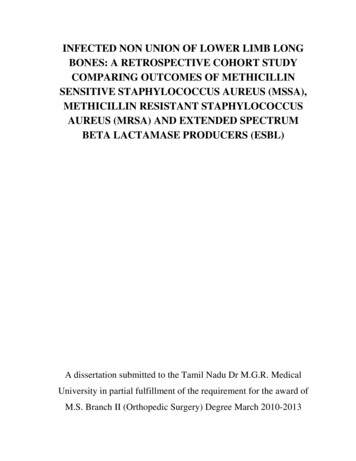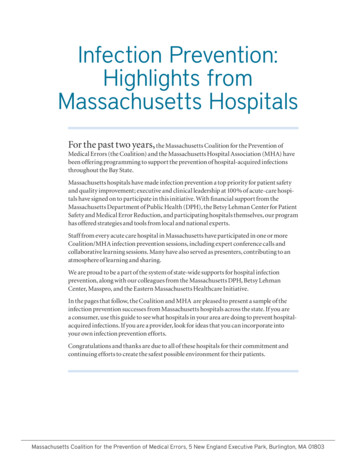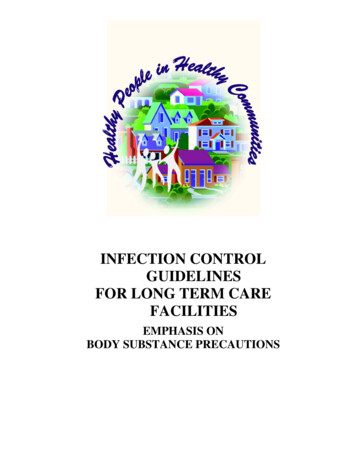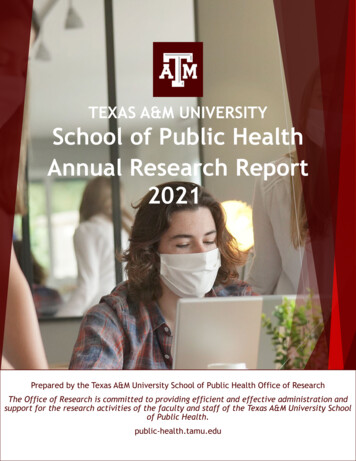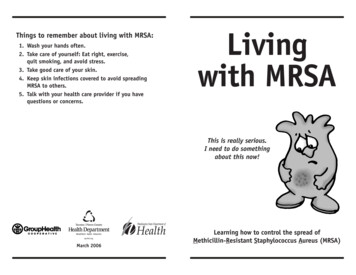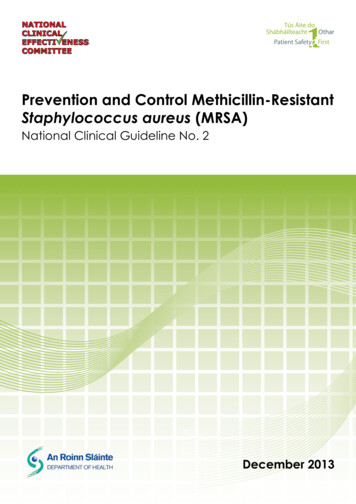
Transcription
Prevention and Control Methicillin-ResistantStaphylococcus aureus (MRSA)National Clinical Guideline No. 2December 2013
Guideline Development GroupThe Prevention and Control of Methicillin-resistant Staphylococcus aureus (MRSA) National ClinicalGuideline was developed by the Royal College of Physicians Ireland (RCPI) Clinical Advisory Groupon healthcare associated infections (HCAI) - Subgroup MRSA Guideline Committee.Using this National Clinical GuidelineThis document is intended to be relevant to all healthcare staff involved in the care of patients,residents or clients who may be at risk of or have MRSA in acute hospitals, nursing homes/longstay residential units and the community.A summary version of the National Clinical Guideline, is available on the website:www.patientsafetyfirst.ieDisclaimerThe National Clinical Guideline Development Group’s expectation is that healthcare professionalswill use clinical judgment and knowledge in applying the general principles and recommendationscontained in this document. Recommendations may not be appropriate in all circumstances anddecisions to adopt specific recommendations should be made by the practitioner taking intoaccount the circumstances presented by individual patients and available resources.Antibiotic stewardship is the subject of on-going research and debate. Local antibiotic susceptibilitydata should be used to guide treatment having due regard to the clinical judgement of theprescriber and the individual circumstances of each patient. Therapeutic options should bediscussed with a clinical microbiologist or infectious disease physician on a case-by-case basis asnecessary.ISSN 2009-6259
National Clinical Effectiveness Committee (NCEC)The National Clinical Effectiveness Committee (NCEC) was established as part of the PatientSafety First Initiative in September 2010. The NCECs mission is to provide a framework for nationalendorsement of clinical guidelines and audit to optimise patient and service user care. The NCEChas a remit to establish and implement processes for the prioritisation and quality assuranceof clinical guidelines and clinical audit so as to recommend them to the Minister for Health tobecome part of a suite of National Clinical Guidelines and National Clinical Audit.National Clinical Guidelines are “systematically developed statements, based on a thoroughevaluation of the evidence, to assist practitioner and service users’ decisions about appropriatehealthcare for specific clinical circumstances across the entire clinical system”. The implementationof clinical guidelines can improve health outcomes, reduce variation in practice and improve thequality of clinical decisions.The aim of National Clinical Guidelines is to provide guidance and standards for improving thequality, safety and cost effectiveness of healthcare in Ireland. The implementation of NationalClinical Guidelines will support the provision of evidence based and consistent care across Irishhealthcare services.The oversight of the National Framework for Clinical Effectiveness is provided by the NCEC. TheNCEC is a partnership between key stakeholders in patient safety and its Terms of Reference areto:- Apply criteria for the prioritisation of clinical guidelines and audit for the Irish health system- Apply criteria for quality assurance of clinical guidelines and audit for the Irish health system- Disseminate a template on how a clinical guideline and audit should be structured, howaudit will be linked to the clinical guideline and how and with what methodology it shouldbe pursued- Recommend clinical guidelines and national audit, which have been quality assured againstthese criteria, for Ministerial endorsement within the Irish health system- Facilitate with other agencies the dissemination of endorsed clinical guidelines and auditoutcomes to front-line staff and to the public in an appropriate format- Report periodically on the implementation of endorsed clinical guidelines.It is recognised that the health system as a whole, is likely to be able to effectively implementand monitor only a small number of new National Clinical Guidelines each year. Not all clinicalguidelines will be submitted for national endorsement and clinical guideline development groupscan continue to develop clinical guidelines using an evidence based methodology in responseto the needs of their own organisations.Information on the NCEC and endorsed National Clinical Guidelines is available on the PatientSafety First website at www.patientsafetyfirst.ie
Table of Contents1.0 Definition of methicillin-resistant Staphlococcus aureus (MRSA) andscope of the National Clinical Guideline1.1 Definition of MRSA1.2 Scope of the National Clinical Guideline1.3 Aim of guideline1.4 Objectives555662.0 Recommendations2.1 Prevention and control2.1.1 Screening2.1.2 Infection prevention and control measures in the acute hospital setting2.1.3 MRSA in the non-acute healthcare setting2.1.4 MRSA in obstetrics and neonates2.1.5 Community-associated MRSA2.1.6 Eradication of MRSA carriage (decolonisation)2.1.7 Antimicrobial stewardship in the prevention and control of MRSA2.1.8 Occupational health aspects of MRSA2.2 Management of MRSA2.2.1 Treatment and prophylaxis2.3 Surveillance2.4 Evaluation and audit88813202629384446555566683.0 Background and methodology3.1 Economic impact report3.2 Need for a revised guideline3.3 Methodology3.3.1 Guideline development group3.3.2 Literature review3.3.3 Grading of recommendations3.3.4 Review date3.4 Target population3.5 Implementation of the National Clinical Guideline3.6 Barriers and facilitators to implementation3.7 Guiding principles for the National Clinical Guideline3.8 Roles and responsibilities3.8.1 Organisational responsibility3.8.2 Clinical staff3.9 Key audit criteria707072737374757575757676777777774.0 Appendices78Appendix IAbbreviations78Appendix IIGlossary80Appendix IIIGuideline development group membership and conflicts of interest83Appendix IVConsultation process85Appendix VHow to obtain a nasal swab88
Appendix VITemplate letter to general practitioner and copied to consultant89Appendix VIIRisk stratification tool for the isolation and cohorting of MRSA patients90Appendix VIIIInfection prevention and control measures advised when caring for residentscolonised or infected with MRSA in residential care facilities92Appendix IXMRSA- Information for schools and day care facilities for children95Appendix XMatrix for work restrictions in colonised healthcare workers99Appendix XIMRSA surveillance definitions100Appendix XIIMRSA- Related process indicators102Appendix XIIIAreas for Further Research103Appendix XIVAmbulance transportation of patients colonised/infected with MRSA105Appendix XVEconomic impact report1065.0 ReferencesTablesTable 1:Table 2:Table 3:Table 4:Table 5:Table 6:Table 7:Elements of a programme to prevent and control MRSA to promote safequality careKey Components of Standard PrecautionsPractical guidance on antibiotic choices for the management of moderateCA-MRSA SSTIDefinition of contacts of CA-MRSA index casesRisk Factors for MRSA in HCWsTreatment - practical guidance for MRSA infections in adultsEstimation of the costs of HCAI in Ireland for 2011 extrapolated from nationaland international sources1227223336505772FiguresFigure 1 Practical guidance for the management of suspected CA-MRSA infection34Figure 2 Practical guidance - algorithm for decolonisation of confirmed CA-MRSA infection 36Figure 3 Practical guidance for the management of MRSA43
A National Clinical Guideline1.01.1Prevention and Control MRSADefinition of methicillin-resistant Staphlococcus aureus(MRSA) and scope of the National Clinical GuidelineDefinition of MRSAStaphylococcus aureus (S. aureus) commonly colonises the skin and nose. Methicillin-resistantStaphylococcus aureus (MRSA) infection is caused by a strain of bacteria that has becomeresistant to the antibiotics commonly used to treat ordinary staphylococcal infections.In the right setting MRSA can cause severe and at times fatal infections such as bloodstreaminfection (BSI), infective endocarditis, pneumonia and skin and soft tissue infections (SSTI).1.2Scope of the National Clinical GuidelineThe guideline is relevant to and has been developed for all healthcare staff involved in the care ofpatients, residents or clients who may be at risk of or may have MRSA in acute hospitals, obstetrics andneonates, nursing homes/long stay residential units and the community. Such members of staff includemedical practitioners, nurses, midwives, healthcare assistants, biomedical scientists, pharmacistsand allied healthcare professionals. This guideline acknowledges changes in epidemiology, i.e. theemergence of community-acquired MRSA (CA-MRSA).The public and patients will find this guideline of interest as it outlines the general and specific measuresrequired to prevent and control MRSA and how these can and should be incorporated into qualitymeasures to safeguard the quality of patient care. In addition, a summary version of this document,outlining the recommendations, is also available.This guideline updates the last set of guidelines on MRSA which were published in 2005 by the HealthProtection Surveillance Centre (HPSC).The guideline does not address the following:i) Issues relating to antibiotic resistance, including MRSA in the agri-farming sectorii) The challenges of developing new drugs for the treatment of invasive MRSA infectioniii) The potential implications of laboratory modernisation which will include rationalisation andthe centralisation of some services, including the laboratory diagnosis of and screening forMRSA.The recommendations are followed by a grade. This is a consensus grade agreed by the MRSAguideline development group (Appendix III) reflecting the strength of the evidence supporting therecommendation, and discussion of the evidence amongst the MRSA guideline development group.The system below, as used in the 2005 guidelines was felt to best meet the needs of the guideline andthe guideline development group, given the absence of randomised controlled trials (RCTs) in manyof the areas covered.The grades used throughout the guideline document are as follows:Grade AEvidence from a meta-analysis of RCTs, or from at least one RCT.Grade BEvidence based on one controlled trial without randomisation, a quasi-experimentalstudy, or extrapolated from RCTs.Grade CEvidence from comparative studies, correlation studies, case control studies orextrapolated from category A or B.5
6Prevention and Control MRSAGrade DA National Clinical GuidelineEvidence from expert committees, reports or opinions, the clinical experience ofrespected authorities, and the conclusions of the guideline development group.A consultation process was completed (Appendix IV).1.3 Aim of guidelineTo provide practical guidance on prevention and control measures for MRSA to improve patient care,minimise patient morbidity and mortality and to help contain healthcare costs.1.4 ObjectivesThe objectives of this guideline are: to enhance and further improve the prevention and control of MRSA since the publicationof previous guidelines in 2005. to improve the safety and quality of patient care through reducing further the prevalenceof MRSA BSI and to prevent other serious infections such as SSTI, respiratory tract, bone andjoint infections caused by MRSA. to improve the use of antibiotics specifically for MRSA infections and to contribute to otheraspects of antibiotic stewardship. to raise awareness of healthcare-associated infection (HCAI), amongst the public and allhealthcare professionals about the measures required for prevention and control, e.g.standard precautions and the importance of their implementation.Table 1 gives an overview of what this guideline would like to achieve in terms of MRSA prevention andcontrol and quality and patient/resident safety issues.
A National Clinical GuidelinePrevention and Control MRSATable 1 Elements of a programme to prevent and control MRSA to promote safe quality careQualityElementPatient/residentcentred carePrevention and control of MRSA is a key priority for all healthcare providersPatient/resident information on MRSA prevention and controlGovernance and reporting systems to provide assuranceImplementation of National Standards for the Prevention and Control ofHealthcare Associated Infections produced by HIQA in 2009Effective careSystems and controls in place to- Monitor compliance with National Standards (HIQA, 2009) and othernational standards relevant to this area- Analyse and learn from MRSA incidents when they occur with disseminationof learning and institution of controls to prevent recurrenceSafe careImplementation of national MRSA, antimicrobial stewardship and hand hygieneguidelinesAudits and assessment of guideline complianceBetter health andwellbeingHealthcare provider education about the prevention of HCAI and MRSAPatient/resident education about the prevention of MRSAEnsure that the healthcare system is designed to do the aboveGovernance,leadership andmanagementAccountability and responsibility for MRSA clearly definedPerformance monitoring undertaken and regularly reviewedCluster/outbreak managementCommunication regarding MRSA with other healthcare providers, patients,residents and the publicMicrobiological services to support MRSA prevention are appropriateHCAI surveillance as a key component of the systemAntimicrobial stewardship as a key component of safe and effective careWorkforceDefined skills, competencies, education and trainingUse of resourcesStrategies to prevent MRSA are cost-effectiveStrategies to promote appropriate antimicrobial use are cost-effectiveHCAI Education is appropriateUse of informationMRSA surveillance, in conjunction with other relevant indicators, e.g. handhygiene compliance is fed back, reviewed and monitored7
8Prevention and Control MRSA2.0A National Clinical GuidelineRecommendationsThe recommendations are numbered 1 to 53 as follows:Prevention and control (Recommendations 1-32)- Screening- Infection prevention and control measures in the acute hospital setting- MRSA in the non-acute healthcare setting- MRSA in obstetrics and neonates- Community-associated MRSA- MRSA decolonisation- Antimicrobial stewardship and the prevention and control of MRSA- Occupational health aspects of MRSAManagement (Recommendations 33-45)- Treatment and prophylaxisSurveillance (Recommendations 46-50)Evaluation and audit (Recommendations 51-53)The recommendations are linked to the best available evidence and/or expert opinion usingthe grades for recommendations outlined in Section 1.2. A rationale for the recommendationsis outlined and practical guidance to support the delivery of the recommendations is provided.Prevention and control of MRSA is a multidisciplinary task, involving surveillance, patient screening,decolonisation, isolation and cohorting of patients, environmental cleaning, antimicrobialstewardship, maintaining adequate staffing levels and hand hygiene. The prevention and controlof MRSA are the responsibility of all those who work in the healthcare sector and not just thoseprofessionally involved in infection prevention and control.2.1Prevention and control (Recommendations 1-32)The following are responsible for implementation of recommendations 1-32: clinical teams, seniormanagement and the Infection Prevention and Control Team (IPCT). Public health professionalsand medical scientists have some specific roles as outlined in the relevant recommendations.2.1.1 ScreeningEffective strategies for the prevention and control of MRSA rely on early detection so thatappropriate measures may be implemented. Screening, linked to patient isolation and the use ofcontact precautions (CP) are important. These are precautions intended to prevent transmissionof infectious agents i.e. MRSA, which are spread by direct or indirect contact with a patient or thepatient’s environment and have been shown to be effective in reducing the transmission of MRSA(1-4). Successfully detecting MRSA carriage is influenced by many factors including the laboratorymethods used, the number of times the patient is screened, the types of samples obtained, andwhen they are obtained. It is generally accepted that instituting CP is appropriate for thosepatients known to be colonised with MRSA in the acute setting (5) although there is conflictingevidence on this particular topic (6). What follows in this section largely relates to the acutehealthcare setting. However, screening may be a component of the prevention and control ofCA- MRSA as outlined in section 2.1.5.
A National Clinical GuidelinePrevention and Control MRSA9Recommendation 1Continue with targeted MRSA screening (i.e. patients at risk of acquiring MRSA), and not universalscreening (i.e. all patients on admission to acute hospitals), pending further data on its efficacyand feasibility. Grade DRecommendation 2All patients (in-patients, out-patients and other patients in the community) identified with MRSAshould be informed as soon as possible of their MRSA status, which should be documented in thepatients’ clinical notes and information should be provided about eradication/treatment options,as appropriate. Grade DPractical GuidanceWho to screen and whena) The taking of screening samples to determine MRSA status should not adversely affect theindividual patient’s access to clinical care, e.g. urgent surgery should be carried out withappropriate precautions and surgical prophylaxis, and not be delayed by the taking ofspecimens or by waiting for results. Grade Db) Patients who should be screened on admission for MRSA because they are at risk of havingacquired MRSA (i.e. targeted screening) include the following: Patients known to be previously positive and who are being re-admitted to an acutehospital. Grade C Patients admitted directly from another hospital or healthcare facility, e.g. nursing home.Grade C Patients who have been an in-patient in another healthcare facility, i.e. in acute hospitalor long term care facility, in the last six months. Grade C Patients transferred from a hospital abroad or patients who have been an in-patient in ahospital abroad during the previous 12 months. Grade C Patients with non-intact skin, including wounds and ulcers and also exfoliative skinconditions, percutaneous endoscopic gastrostomy tubes, urinary catheters and centralvenous catheters. Grade C Clients due to undergo elective high and medium risk surgery (e.g. cardiothoracic andvascular surgery, orthopaedic implant surgery). In addition, hospitals should assess whichpatient groups undergoing surgery have a relatively high risk of MRSA infection andconsider pre-operative screening for those particular patient sub-sets. For example, itmay be appropriate for hospitals to screen emergency orthopaedic admissions as manyof these patients are elderly and have frequent contact with the healthcare system.Grade C Patients admitted to critical care areas, e.g. intensive care unit (ICU) and special carebaby unit (SCBU) with at least weekly screening thereafter. Grade D Patients requiring renal dialysis. Grade C Any healthcare worker involved in direct patient contact, being admitted to an acutehealthcare facility. Grade Dc) Patients who require screening for MRSA subsequent to hospital admission include: During an outbreak or cluster. Grade D Patients transferred to critical care areas e.g. ICU and SCBU with at least weekly screeningthereafter. Grade D Patients requiring renal dialysis require quarterly screening. Grade C
10Prevention and Control MRSAA National Clinical Guideline Patients who have been successfully decolonised, i.e. three negative follow-up samplesat least 48 hours apart, should continue to be screened at weekly intervals while in anacute hospital setting. Grade C Other patients, as determined by local risk assessment. Grade Dd) Screening samples Swabs from the anterior nares, perineum or groin, throat, catheter specimen of urine(CSU), sputum if productive cough and any skin lesions (e.g. surgical site, PEG tube site)should be obtained. Grade C Additional samples to diagnose infection (e.g. blood, vascular catheter tip) should betaken as clinically indicated. Grade De) Laboratory methods Laboratories should continue with culture-based methods for the detection of MRSA.Grade D Ideally, broth-enrichment should be used but this results in an additional delay in theissuing of results and the decision needs to be assessed locally. Grade B The advent of rapid diagnostic testing for MRSA with the polymerase chain reaction(PCR) is a welcome development and it may be appropriate for individual laboratories/hospitals to introduce rapid diagnostic testing for certain patient groups, e.g. emergencysurgical or ICU admissions and to evaluate its impact. Grade Df) Informing patients of MRSA status The responsibility of informing patients of their MRSA status lies with the clinical team (i.e.consultant) caring for the patient during their in-patient stay. Grade D Where a new MRSA case is diagnosed following patient discharge or when a patientis attending an outpatient clinic, it is the clinical team’s responsibility (i.e. consultant)to inform the patient’s general practitioner of his/her MRSA status and to follow up asrequired. Grade D If MRSA is detected upon the patient’s admission to a particular healthcare facility, thefacility from where the patient was originally transferred needs to be informed. Grade D An information leaflet (e.g. HPSC leaflet) should be given to all patients colonised orinfected with MRSA and this should be documented in the patient’s clinical notes. Grade CRationaleThe NHS Scotland MRSA Screening Pathfinder Programme identified the following patients requiringscreening for MRSA (7): Patients who are not admitted to hospital from their own home Patients with a previous history of MRSA Patients with any prosthetic device (e.g. urinary or vascular catheter) in situ or who havebroken skin (e.g. ulcers).Currently, there is an on-going discussion between the advantages and disadvantages of targetedversus universal screening, and our conclusions based on the evidence currently available are asfollows (8).Targeted screening (patients with risk factors (see above) for MRSA carriage that are likely to bepositive)Previous Irish and UK guidelines have advocated this approach.
A National Clinical GuidelinePrevention and Control MRSAThe justification for targeted screening is that up to 75% of patients with MRSA will remainunrecognised if clinical cultures alone, e.g. swabs to confirm the diagnosis of surgical (wound) siteinfection, are used to detect them (8-10).Universal screening (all patients on admission to hospital)This approach has been recommended in the UK i.e. Scottish Health Technology Assessmentand by the NHS in England and Wales (8,9). The latter states that “From April 2009, all electiveadmissions must be screened for MRSA in line with Department of Health Practical Guidance. Thisshould be extended to cover emergency admissions as soon as possible and definitely no laterthan 2011”. The NHS Scotland MRSA Screening Pathfinder Programme reported on the results of aone year programme for universal screening in NHS Scotland (7). They found that 3.9% of patientadmissions were colonised with MRSA. Short length of stay prevented patients from completingdecolonisation regimens and in only one of 33 patients who were MRSA positive on admissionwas decolonisation completed. Only half of the patients found to be MRSA positive on admissioncould be isolated. This was due to a combination of factors including short length of stay and alack of isolation rooms. The report suggested that clinical risk assessment may be a cost-effectivefirst stage screening process for specialties with large numbers of patients, such as medicine andgeneral surgery. A report on the sensitivity and specificity of this screening method is expected inthe near future. In a recent study of targeted versus universal screening in 892 patients in a largeIrish hospital, 8% of at risk patients were MRSA positive on screening compared to 1% of non-riskpatients, i.e. an additional four patients were detected in that cohort that would not normally bescreened (11). This was also associated with significant additional costs, i.e. approximately 33%increase in cost. A review of screening for MRSA in Newcastle-Upon-Tyne, England, where universalscreening is now routine found that the additional laboratory costs to detect those patients notdetected by targeted screening were 20,000 and the authors concluded that screening basedupon clinical risk was more pragmatic and cost-effective (12).Ideally at-risk patients for MRSA should be screened before admission if possible, such as whenthe admission is elective (i.e. at outpatients) and no more than three months before admission,or at the very least, on admission if emergency or urgent admission. However, every effort shouldbe made to ensure that the process of screening before admission per se does not adverselyimpact on patient care such as resulting in delays in the emergency department (10). Periodice.g. weekly surveillance cultures, should continue to be taken from patients remaining in high-riskareas of the hospital, e.g. ICUs, SCBUs, orthopaedic units, solid organ or bone marrow transplant,especially where MRSA is epidemic or where it has been endemic in the past, or in wards with longstay patients, wards receiving transfers from high risk areas or wards where patients have devices.This will assist in minimising transmission from patients who although negative on admission, havesubsequently acquired MRSA while an in-patient.Patients, with MRSA, who have had three consecutive negative sets of screening samples, atleast 48 hours apart after decolonisation regimens, can be removed from isolation. However,such patients should continue to be screened while in hospital to allow for re-acquisition of MRSAbut currently there are no clear indications as to how often this should be and currently this is bestdecided locally according to risk assessment and laboratory resources. It is difficult to decolonisepatients, with MRSA, who have wounds or large areas of non-intact skin (e.g. decubitus ulcers) ordevices (e.g. urinary catheters) and such patients may require isolation until the wound is healed.When re-admitted to hospital in the future, these patients should be placed in isolation pendingthe results of screening samples.Screening is dependent upon adequate laboratory infrastructure.Screening SamplesThe anterior nares is the most important site to sample but omitting sampling of the throat andperineum will miss a proportion of patients who are colonised with MRSA (13-18). While some authorssuggest that the addition of throat swabs does not increase sensitivity significantly, the guideline11
12Prevention and Control MRSAA National Clinical Guidelinedevelopment group considers it appropriate to include screening the throat, notwithstanding theadditional expense, to maximise the detection of MRSA in screened patients (14, 18, 19, 20-23).This becomes especially important if there is a decline overall in the number of patients detectedwith MRSA when detecting additional cases to drive down the numbers further becomes relevant.(See Appendix V for details on how to obtain a nasal swab)Laboratory Screening MethodsThe screening methods currently most commonly used are: Broth enrichment culture followed by agar subcultureBroth enrichment is followed by sub-culture to chromogenic media and is probably thecurrent ‘gold’ standard as it is the most sensitive method. The disadvantage is the time delay(up to 48 hours) to a positive result. Chromogenic agar plating, direct cultureThis method is less sensitive than broth-enrichment culture but has the benefit of a more rapidresult (preliminary results after overnight incubation), due to the use of a selective medium. Polymerase chain reaction, i.e. rapid testingThere are a number of commercially available rapid diagnostic tests that perform well andare comparable to broth enrichment culture (24). Recent evidence suggests that morerapid results can impact on MRSA transmission and may improve compliance with screeningrecommendations (25,26). Some of these techniques have been evaluated to detectcommon circulating strains of MRSA in Ireland and have been shown to be accurate (27).Nonetheless, these laboratory methods are more expensive than conventional culture basedmethodologies and the benefits, in terms of decreased MRSA acquisition and decreasedMRSA infections have not yet been conclusively shown (28). However, it is possible thatthe selective use of PCR may increase the efficiency of healthcare resources, due to theavailability of a more rapid result but this awaits confirmation.Barriers to the implementation of recommended screening policies include inadequatelaboratory facilities and on-going pressures on clinical staff, e.g. increased patient turn overand maintaining adequate staff numbers. However, the active involvement of IPCTs canassist in ensuring that those patients that should be screened are screened in a timely manner.On-going research is required to confirm that targeted screening remains the appropriateapproach as well as indicating the role and especially the cost-effectiveness of molecularmethods for MRSA detection.CommunicationMany complaints from patients, their relatives and the public about HCAI and MRSA relate to poorcommunication including when and if positive MRSA status was conveyed. Patient advocacygroups have prioritised the provision of enhanced information about MRSA to patients and asrapidly as possible, i.e. once confirmed. This is also consistent with clinical governance, professionaland ethical standards, and is endorsed by professional bodies (29). Knowledge o
A National Clinical Guideline Prevention and Control MRSA 5 1.1 Definition of MRSA Staphylococcus aureus (S. aureus) commonly colonises the skin and nose. Methicillin-resistant Staphylococcus aureus (MRSA) infection is caused by a strain of bacteria that has become resistant to the antibiotics commonly used to treat ordinary staphylococcal infections.

